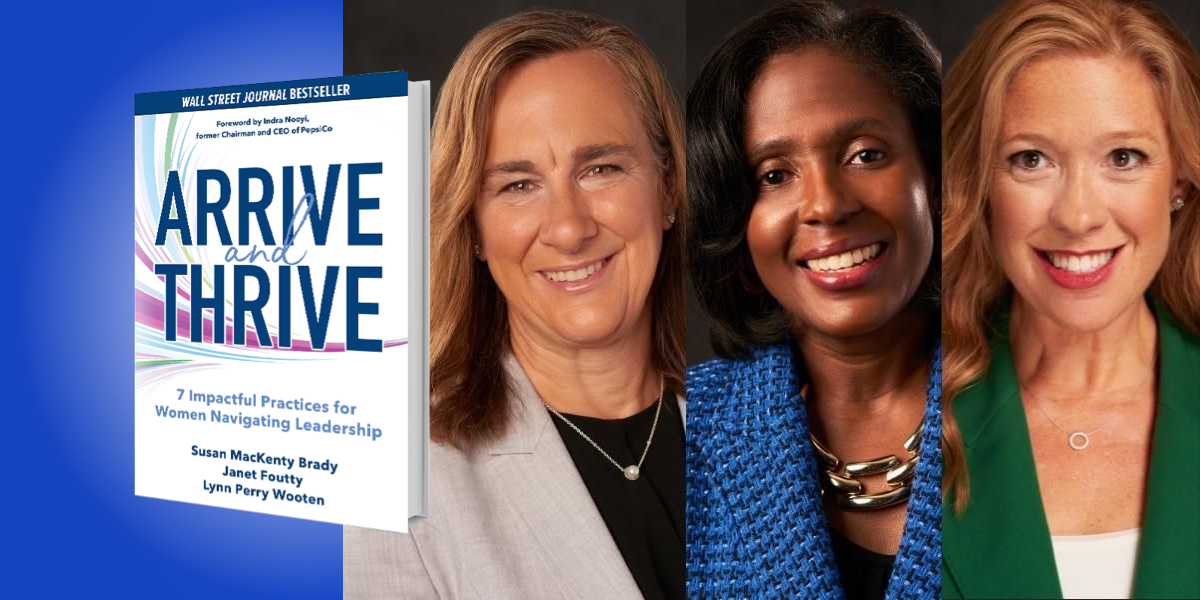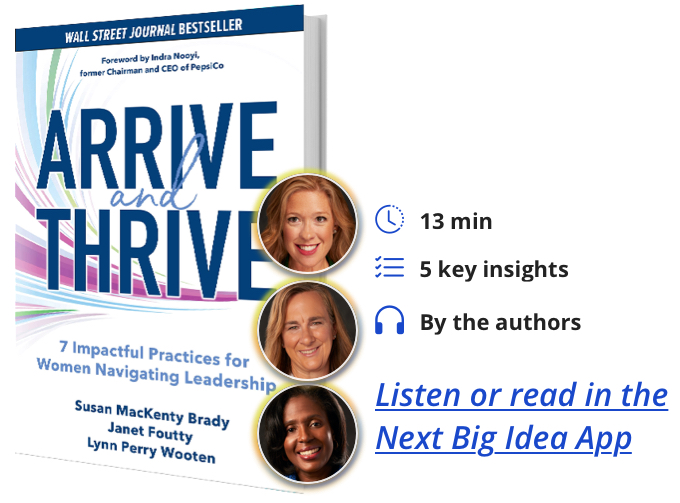Susan MacKenty Brady is the Deloitte Ellen Gabriel Chair for Women and Leadership at Simmons University and the founding CEO of the Simmons University Institute for Inclusive Leadership. Janet Foutty is the Executive Chair of the Board of Deloitte US. Dr. Lynn Perry Wooten is the Simmons University President.
Below, Susan, Janet, and Lynn share 5 key insights from their new book, Arrive and Thrive: 7 Impactful Practices for Women Navigating Leadership. Listen to the audio version—read by Susan herself—in the Next Big Idea App.
1. It’s time for women to arrive and thrive in leadership.
While career women face a multitude of challenges on the way up the corporate ladder, we are seeing steady progress. In 2021, the number of women CEOs on the Fortune 500 hit an all-time record: 41. And for the first time, two Black women are on that list. But women’s rise is inconsistent and slow. Looking at the trends in advancement, women comprise less than a quarter of middle managers, and that number shrinks at each rung of the corporate ladder. The number of female CEOs is 8.1% of the total.
We know firsthand that as women rise into positions of greater responsibility and leadership, the risks associated with sounding, experiencing, or looking vulnerable become greater. Gender based biases abound and even women can be guilty of perpetuating them. Forced into being something women leaders think they should be keeps the cycle of “got to prove myself” or “not good enough” going. As a result, women feel there is little margin for error.
The pandemic underscored the instability of all working women’s lives, putting almost 5 million out of work, and by extension, shrinking the pipeline of future female leaders. Too often, work culture encourages women to get their foot in the door, only to leave them without support once they step in. Without more structural, cultural, and personal support, the risk is that women will always be one economic crisis away from unemployment, underemployment, or career stagnation. For far too long, women leaders have had to focus on survival. However, surviving as a woman leader is the floor, not the ceiling.
“Leading is a collaborative effort—not the voyage of one commander.”
Many women are searching for honest conversations and practical advice on how to not only reach the top, but thrive there. To break through as women leaders, we need to hear from each other, learn from each other, and support each other. Navigating senior leadership is hard enough for anyone, and women face even more challenges. The gendered world we live in makes it harder for women to rise into positions of leadership, and we want women to feel a new level of support and practical wisdom as they navigate their journey.
2. Women need tried and true practices to thrive.
Women in leadership deserve to thrive when they arrive, but hard-won practical and applicable wisdom from other leaders is needed. We aren’t meant to go it alone. Leading is a collaborative effort—not the voyage of one commander.
Navigating our leadership journey requires intention and awareness, and then agility-in-action. We identified seven practices that help women uncover the strength, resilience, and courage to lead in an increasingly complex environment. We have teamed up with well-recognized leaders who shared personal stories and insights—all of whom have put their strategies to the test. Think of the practices as a distillation of the best thinking about how women can thrive in leadership—and by doing so, help others thrive too.
– Practice 1: Investing in Your Best Self.
– Practice 2: Embracing Authenticity.
– Practice 3: Cultivating Courage.
– Practice 4: Fostering Resilience.
– Practice 5: Inspiring a Bold Vision.
– Practice 6: Creating a Healthy Team Environment.
– Practice 7: Committing to the Work of the Inclusive Leader.
The verbs we paired with each practice—fostering, inspiring, cultivating—intentionally illustrate that as leaders our real job is making those around us successful. It is about being the best version of yourself in order to lead, inspire, and raise up others.
3. Bring yourself on your leadership journey.
Don’t leave yourself behind. If you wish to be on a journey of significance, you’ll need to invest in and lead from your best self. Investing in your best self means living your life from the optimum part of you. This requires knowing yourself when you’re at your best, including:
– What your strengths and talents are.
– Where you add value to others.
– What brings you joy and vitality.
Identifying the enablers and blockers to leading from your best, most centered self is critical. Once you know yourself at your best, the job is to learn how to consciously return to your best self over and over again.
“Revisit you on a regular basis.”
Implicit in this notion is that it is impractical to think that you will be able to lead life from your best self every moment of every day. You are human. Feelings arise. You react or get triggered. Disappointments ensue. You change or outgrow relationships or jobs, or they might outgrow you. Life shoves you out of your best self, so you need to hone the practice of a “loving return” to the best parts of you and, ideally, as quickly as possible.
Returning to your best self is a moment-to-moment practice. Nourishing your wellbeing will also change form as you grow and change physically, professionally, mentally, emotionally, and spiritually.
Once you know how to intentionally return to this place, you are ready to honor your own growth by updating your best self as you live out your life. Revisit you on a regular basis. These visits welcome deeper curiosity about your very existence in the present.
4. Being a visionary is a collaboration.
Inspiring a bold vision means discovering what needs to change (it could be seeing a way to innovate, solve a problem, or fundamentally reconstruct something) and then finding the courage to embark on bringing that change to life. It begins with noticing.
You don’t have to be the one to wake up with the brilliant idea to be a visionary. As leaders, having a bold vision doesn’t always come from stewing alone in your office, waiting for inspiration to strike. There are certainly people that wake up with a brilliant idea, and that is one way to create a bold vision, but vision can also come from listening carefully to others and helping connect the dots.
Vision is about noticing a change that would remove a barrier or make something even better. Then, we connect with others to drive a plan and create a language that gets others excited.
A network for building a vision is not incidental. This practice boils down to trusting your judgment as you enroll others, organizing a path to the desired destination, and being the one who harnesses the energy of others to achieve it. Being a visionary is a collaboration.
5. Arriving and thriving is a continuous journey.
Fostering resilience means proactively preparing for the turns that life brings, and rising up through challenges stronger and wiser. Being able to bounce back from hardship requires agility. With every bounce back, you become a better version of your best self. The greatest gift of this practice is the opportunity to deepen your own inner journey while leaning on others for support along the way.
“With every bounce back, you become a better version of your best self.”
If you are a woman leader, chances are you have already built the muscle of resilience. If you identify as other than straight and Caucasian, you know resilience. In many ways, anyone who has faced adversity knows how to adapt and pivot in the face of hardship. Not just because of setbacks, but because we grow and change as our context and needs change. We must orient our perspective about our leadership journey with a continuous learning mindset about ourselves and about leading, inspiring, and raising up others. Throughout our lives we should define, redefine, and fine-tune the seven practices, revisiting them over time, with the curiosity of a life-long learner.
We want you to see each practice as something women and their allies can work on together. The biggest idea of all is that all genders can help create a world where women aren’t just 50% of the world’s population, they are also 50% of the world’s leaders.
To listen to the audio version read by author Susan MacKenty Brady, download the Next Big Idea App today:































